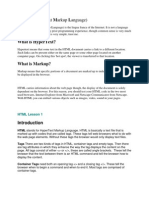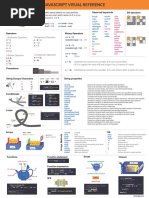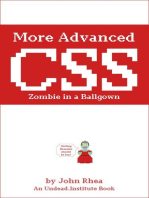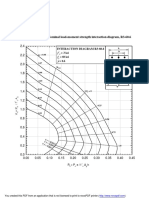100%(1)100% found this document useful (1 vote)
289 viewsCascading Style Sheets
The document discusses cascading style sheets (CSS), including how to specify style rules, use external and inline styles, define classes and IDs, set font properties, and control text formatting. CSS allows applying styles to HTML elements to define visual styles like colors, fonts, spacing and more in a flexible way.
Uploaded by
Jarun DevCopyright
© © All Rights Reserved
Available Formats
Download as PDF, TXT or read online on Scribd
100%(1)100% found this document useful (1 vote)
289 viewsCascading Style Sheets
The document discusses cascading style sheets (CSS), including how to specify style rules, use external and inline styles, define classes and IDs, set font properties, and control text formatting. CSS allows applying styles to HTML elements to define visual styles like colors, fonts, spacing and more in a flexible way.
Uploaded by
Jarun DevCopyright
© © All Rights Reserved
Available Formats
Download as PDF, TXT or read online on Scribd
You are on page 1/ 53
1
2001-2003 Marty Hall, Larry Brown http://www.corewebprogramming.com
core
programming
Cascading
Style Sheets
Cascading Style Sheets 2
www.corewebprogramming.com
Agenda
Specifying style sheet rules
External and inline style specifications
Creating new HTML elements through style
sheet classes
Specifying font and text properties
Controlling foreground and background
properties
Netscape LAYERs
Creating layers through style sheets
Cascading Style Sheets 3
www.corewebprogramming.com
Benefits of Cascading Style
Sheets
Powerful and flexible way to specify the
formatting of HTML elements
Can define font, size, background color, background
image, margins, etc.
Share style sheets across multiple
documents or entire Web site
Can specify a class definition for a style,
effectively defining new HTML elements
Rules are applied in a hierarchical manner
(precedence rules)
Cascading Style Sheets 4
www.corewebprogramming.com
Cascading Style Sheets
CSS, Level 1 (1996)
Concerned with applying simple styles to HTML elements
http://www.w3.org/TR/REC-CSS1
CSS, Level 2 (1998)
Supports media-specific style sheets (visual browsers, aural devices,
printers, braille devices)
http://www.w3.org/TR/REC-CSS2
CSS, Level 3 (draft 2001)
Focused on modularization of the CSS specification
http://www.w3.org/TR/css3-roadmap/
Note:
CSS1 is supported by Netscape and Internet Explorer 4.x and above
See http://www.webreview.com/style/css1/charts/mastergrid.shtml
for a summary of browser compatibility
Cascading Style Sheets 5
www.corewebprogramming.com
Specifying Style Rules
General form of rule
selector { property: value }
or
selector { property1: value1;
property2: value2;
...
propertyN: valueN }
Example
H1 { text-align: center;
color: blue }
Cascading Style Sheets 6
www.corewebprogramming.com
Fizzics1.html, Example
(no style sheet)
<!DOCTYPE HTML PUBLIC "-//W3C//DTD HTML 4.0 Transitional//EN">
<HTML>
<HEAD>
<TITLE>New Advances in Physics</TITLE>
</HEAD>
<BODY>
<H1>New Advances in Physics</H1>
<H2>Turning Gold into Lead</H2>
In a startling breakthrough, scientist B.O. "Gus" Fizzics
has invented a <STRONG>practical</STRONG> technique for
transmutation! For more details, please see
<A HREF="give-us-your-gold.html">our transmutation thesis</A>.
...
</BODY>
</HTML>
Cascading Style Sheets 7
www.corewebprogramming.com
Fizzics1.html, Result
(no style sheet)
Cascading Style Sheets 8
www.corewebprogramming.com
Fizzics2.html, Example
(with style sheet)
Style information
<HEAD>
<TITLE>Document Title</TITLE>
<STYLE TYPE="text/css">
<!--
BODY { background: URL(images/confetti-background.jpg) }
H1 { text-align: center;
font-family: Blackout }
H2 { font-family: MeppDisplayShadow }
STRONG { text-decoration: underline }
-->
</STYLE>
</HEAD>
Cascading Style Sheets 9
www.corewebprogramming.com
Fizzics2.html, Result
(with style sheet)
Cascading Style Sheets 10
www.corewebprogramming.com
External Style Sheets
Specify link to external style sheet in the HEAD
section of the HTML document
<LINK REL=STYLESHEET
HREF="Sitestyle.css" // Absolute or relative link
TYPE="text/css">
Sitestyle.css
/* Example of an external style sheet */
H1 { text-align: center;
font-family: Arial
}
H2 { color: #440000;
text-align: center;
font-family: Arial Black, Arial, Helvetica, sans-serif
}
...
Cascading Style Sheets 11
www.corewebprogramming.com
Inline Style Specification
Use the STYLE attribute defined for each
HTML element to directly specify the style
Example
...
<H1>New Advances in Physics</H1>
<P STYLE="margin-left: 0.5in;
margin-right: 0.5in;
font-style: italic">
This paper gives the solution to three
previously unsolved problems: turning lead into gold,
antigravity, and a practical perpetual motion machine.
...
Cascading Style Sheets 12
www.corewebprogramming.com
Defining Style Classes
To define an element style class proceed
the HTML element by a period and class
name
// Define an "abstract" paragraph type
P.abstract { margin-left: 0.5in;
margin-right: 0.5in;
font-style: italic }
To use, supply the name of the style class in
the CLASS attribute of the HTML element
<H1>New Advances in Physics</H1>
<P CLASS="abstract">
This paper gives the solution to three previously
unsolved problems: turning lead into gold,
antigravity, and a practical perpetual motion machine.
Cascading Style Sheets 13
www.corewebprogramming.com
Defining Style Classes
To define a global style class, omit the
element name
// Style available to all elements
.blue { color: blue; font-weight: bold }
To use, simple specify the style class in the
CLASS attribute of the HTML element
<H2 CLASS="blue">A Blue Heading</H2>
<!-- Apply to a section of text -->
This text is in the default color, but
<SPAN CLASS="blue">this text is blue.</SPAN>
Cascading Style Sheets 14
www.corewebprogramming.com
Defining Styles through
User-Defined IDs
An ID is like a class but can be applied only
once in a document
<HEAD>
<TITLE>...</TITLE>
<STYLE TYPE="text/css">
<!--
#foo { color: red }
-->
</STYLE>
</HEAD>
<BODY>
...
<P ID="foo">
...
</BODY>
Cascading Style Sheets 15
www.corewebprogramming.com
Style Sheet Precedence Rules
1. Rules marked important have the highest
priority (rarely used)
H1 { color: black !important;
font-family: sans-serif }
2. Author rules have precedence over reader
rules
Style sheet rules override browser preferences
Cascading Style Sheets 16
www.corewebprogramming.com
Style Sheet Precedence Rules,
cont.
3. More specific rules have precedence over
less specific rules
#foo { ... } // ID selector highest priority
P.big H1 { ... } // Class higher over element
P STRONG { ... } // Two tags higher than single tag
STRONG { ... }
4. In case of tie, the last rule has priority
Cascading Style Sheets 17
www.corewebprogramming.com
Useful Font Properties
font-weight
Relative weight (boldness) of font
normal | lighter | bold | bolder | 100 | 200 | ... | 900
H1 { font-weight : 200 }
H2 { font-weight : bolder }
font-style
Font face type within a family
normal | italic | oblique
P { font-style : normal }
TH { font-sytle : italic }
Cascading Style Sheets 18
www.corewebprogramming.com
Useful Font Properties, cont.
font-size
Either relative or absolute size of font
pt, pc, in, cm, mm | em, ex, px, % |
xx-large | x-large | large | medium | small | x-small |
xx-small | smaller | larger
STRONG { font-size: 150% }
P { font-size: 14pt }
P { font-size: xx-large }
font-family
Typeface family for the font
H1 { font-family: Arial }
Cascading Style Sheets 19
www.corewebprogramming.com
CampBearClaw.html, Example
<!DOCTYPE HTML PUBLIC "-//W3C//DTD HTML 4.0 Transitional//EN">
<HTML>
<HEAD>
<TITLE>Camp Bear Claw</TITLE>
<LINK REL=STYLESHEET HREF="CampBearClaw.css" TYPE="text/css">
</HEAD>
<BODY>
<H1>Camp Bear Claw</H1>
We have the following activities:
<H2 CLASS="archery">Archery</H2>
<H2 CLASS="arts">Arts and Crafts</H2>
<H2 CLASS="horseback">Horseback Riding</H2>
<H2 CLASS="hiking">Hiking</H2>
<H2 CLASS="campfire">Campfire Song Times</H2>
<H2 CLASS="java">Java Programming</H2>
</BODY>
</HTML>
Cascading Style Sheets 20
www.corewebprogramming.com
CampBearClaw.css
H1 { text-align: center;
font-family: Funstuff }
H2.archery { font-family: ArcheryDisplay }
H2.arts { font-family: ClampettsDisplay }
H2.horseback { font-family: Rodeo }
H2.hiking { font-family: SnowtopCaps }
H2.campfire { font-family: Music Hall }
H2.java { font-family: Digiface }
Cascading Style Sheets 21
www.corewebprogramming.com
CampBearClaw.html, Result
Cascading Style Sheets 22
www.corewebprogramming.com
Useful Text Properties
text-decoration
Describes text additions or decorations that are added
to the text of an element
none | underline | overline | line-through | blink
P { text-decoration: underline }
vertical-align
Determines how elements are positioned vertically
top | bottom | baseline | middle | sub | super | text-top |
text-bottom | %
text-align
Determines how paragraphs are positioned horizontally
left | right | center | justify
Cascading Style Sheets 23
www.corewebprogramming.com
Useful Text Properties, cont.
text-indent
Specifies the indentation of the first line of the paragraph
+/ pt, pc, in, cm, mm | +/ em, ex, px, %
P { text-indent: -25px } /* Hanging indent */
line-height
Specifies the distance between two consecutive baselines
in a paragraph
normal | number | pt, pc, in, cm, mm | em, ex, px, %
.double { line-height: 200% }
.triple { line-height: 3 } /* 3x the font size */
DIV { line-height: 1.5em }
Cascading Style Sheets 24
www.corewebprogramming.com
Bates.html
<!DOCTYPE HTML PUBLIC "-//W3C//DTD HTML 4.0 Transitional//EN">
<HTML>
<HEAD>
<TITLE>An Open Letter to the IRS</TITLE>
<LINK REL=STYLESHEET HREF="Bates.css" TYPE="text/css">
</HEAD>
<BODY BACKGROUND="images/bond-paper.jpg">
<P CLASS="rhead">
April 1, 2001
<HR>
<P CLASS="rhead">
William A. Bates<BR>
Macrosoft Corporation<BR>
Blumond, WA 12345
<P CLASS="lhead">
Internal Revenue Service<BR>
Philadelphia, PA 67890
<P>
<BR>
Dear Sirs,
<P CLASS="body">
I am writing to inform you that, due to financial difficulties,
...
Cascading Style Sheets 25
www.corewebprogramming.com
Bates.css
P { margin-top: 5px }
P.rhead { text-align: right;
margin-right: 0.5in;
font-family: sans-serif }
P.lhead { font-family: sans-serif }
P.body { text-align: justify;
text-indent: 0.5in }
P.foot { margin-left: 60%;
line-height: 300% }
Cascading Style Sheets 26
www.corewebprogramming.com
Bates.html
Cascading Style Sheets 27
www.corewebprogramming.com
Useful Foreground and
Background Properties
color
Color of the text or foreground color
color-name | #RRGGBB | #RGB | rgb(rrr, ggg, bbb) |
rgb(rrr%, ggg%, bbb%)
P { color : blue }
H1 { color : #00AABB }
H3 { color : rgb(255, 0, 0 ) } /* red */
background-image
none | url(filename)
Specifies an image to use as the background of region
H2 { background-image: url(Bluedrop.gif);}
Cascading Style Sheets 28
www.corewebprogramming.com
Useful Foreground and
Background Properties, cont.
background-repeat
Specifies how to tile the image in the region
repeat | repeat-x | repeat-y | norepeat
BODY {
background-image: url(Bluedot.gif);
background-repeat: repeat-x;
}
background
Lets you combine properties in a single entry
P { background: url(wallpaper.jpg) repeat-x }
Cascading Style Sheets 29
www.corewebprogramming.com
Cabinets.html, Example
<!DOCTYPE HTML PUBLIC "-//W3C//DTD HTML 4.0 Transitional//EN">
<HTML>
<HEAD>
<TITLE>Joe's Cabinets</TITLE>
<LINK REL=STYLESHEET HREF="Cabinets.css" TYPE="text/css">
</HEAD>
<BODY>
<CENTER>
<TABLE WIDTH=360 HEIGHT=199>
<TR><TD ALIGN="CENTER" CLASS="banner">Joe's Cabinets
</TABLE>
</CENTER>
<P>
Welcome to Joe's Cabinets. We specialize in
<UL>
<LI>Custom Cabinets
<LI>Kitchen Remodeling
<!-- Etc -->
</UL>
<!-- Etc -->
</BODY>
</HTML>
Cascading Style Sheets 30
www.corewebprogramming.com
Cabinets.css
.banner { background: url(images/boards.jpg) repeat-x;
font-size: 50pt;
font-family: Arial Rounded MT Bold }
Cascading Style Sheets 31
www.corewebprogramming.com
Cabinets.html, Result
Cascading Style Sheets 32
www.corewebprogramming.com
Properties of the Bounding Box
CSS assume that all elements result in one
or more rectangular regions (bounding box)
Styles can specify the margins, borders,
and padding of the bounding box
P { margin: 0.25in;
border: 0.25in solid black;
padding: 0.25in;
background: URL(images/bond-paper.jpg) }
Cascading Style Sheets 33
www.corewebprogramming.com
The Bounding Box
Cascading Style Sheets 34
www.corewebprogramming.com
Images and Floating Elements
width, height
Specify a fixed size for an element (usually an image)
auto | pt, pc, in, cm, mm | em, ex, px
IMG.bullet { width: 50px; height: 50px }
float
This property lets elements float into the left or right
margins where the text wrapping arounds
none | left | right
Cascading Style Sheets 35
www.corewebprogramming.com
Psalm23.html
<!DOCTYPE HTML PUBLIC "-//W3C//DTD HTML 4.0 Transitional//EN">
<HTML>
<HEAD>
<TITLE>The 23rd Psalm</TITLE>
<STYLE>
<!--
SPAN { float: left;
font-family: "Cushing Book";
font-size: 75pt }
-->
</STYLE>
</HEAD>
<BODY>
<H2 ALIGN="CENTER">
The 23rd Psalm (King James Version)</H2>
<SPAN>T</SPAN>he LORD is my shepherd; I shall not want.
He maketh me to lie down in green pastures: he leadeth me
beside the still waters. He restoreth my soul: he leadeth me
in the paths of righteousness for his name's sake. Yea,
Cascading Style Sheets 36
www.corewebprogramming.com
Psalm23.html, Result
The float property can be used
to implement drop caps
Cascading Style Sheets 37
www.corewebprogramming.com
Effect of Paragraph Breaks,
Example, cont.
Adding a <P> element simply
continues the flow
Adding <P STYLE="clear: left">
forces the next paragraph to start after
the floating element
Cascading Style Sheets 38
www.corewebprogramming.com
Netscape Layers
Layers (LAYER and ILAYER elements) allow
you to:
Place HTML markup in separate regions
Position each region on the page
LAYER and ILAYER are only supported in
Netscape 4
Layers are not supported in Internet Explorer or
Netscape 6
Cascading Style Sheets 39
www.corewebprogramming.com
LAYER and ILAYER
LAYER element
The LAYER element creates regions that have an
absolute position with respect to the window or parent
layer
ILAYER
The ILAYER element creates inline layers (regions that
are embedded in the flow of the text)
Cascading Style Sheets 40
www.corewebprogramming.com
LAYER, Example
<!DOCTYPE HTML PUBLIC "-//W3C//DTD HTML 4.0 Transitional//EN">
<HTML>
<HEAD>
<TITLE>Using ABOVE and BELOW</TITLE>
</HEAD>
<BODY>
<H1>Using <CODE>ABOVE</CODE> and <CODE>BELOW</CODE></H1>
<LAYER ID="Top" LEFT=60 TOP=120
WIDTH=500 HEIGHT=100 BGCOLOR="#F5DEB3">
This layer is on top, even though it appears
first in the HTML document.
</LAYER>
<LAYER ID="Bottom" ABOVE="Top" LEFT=10 TOP=70
WIDTH=500 HEIGHT=100 BGCOLOR="gray">
This layer is on the bottom, even though it appears
second in the HTML document.
</LAYER>
</BODY>
</HTML>
Cascading Style Sheets 41
www.corewebprogramming.com
LAYER, Result
Netscape 4 layers can specify the relative order of the layers.
Cascading Style Sheets 42
www.corewebprogramming.com
ILAYER, Example
<!DOCTYPE HTML PUBLIC "-//W3C//DTD HTML 4.0 Transitional//EN">
<HTML>
<HEAD>
<TITLE>Row, Row, Row Your Boat</TITLE>
</HEAD>
<BODY>
<IMG SRC="images/Rowboat.gif" ALIGN="RIGHT">
<HR>
<B>Row, Row, Row Your Boat</B><BR>
Row, row, row your boat<BR>
Gently
<ILAYER TOP=10>down</ILAYER>
<ILAYER TOP=20>the</ILAYER>
<ILAYER TOP=30>stream<BR>
Merrily, merrily, merrily, merrily<BR>
Life is but a dream<BR>
<HR>
</ILAYER>
</BODY>
</HTML>
Cascading Style Sheets 43
www.corewebprogramming.com
ILAYER, Result
Using TOP in ILAYER can move text up or down in the
current paragraph.
Cascading Style Sheets 44
www.corewebprogramming.com
Specifying Layers with Style
Sheets
Style sheets provide an alternative to
LAYER and ILAYER elements
Style sheet layers are supported by both Netscape and
Internet Explorer
However, Netscape layers are more complete
No equivalent style for PAGEX and PAGEY for
positioning
Problem
Netscape and IE use a different object model to refer to
layers
See http://www.stopbadtherapy.com/standards.shtml for
creating cross-browser layers
Cascading Style Sheets 45
www.corewebprogramming.com
Creating a Style Sheet Layer
Use an ID tag format to define a style
#layer1 { position: absolute;
left: 50px; top: 75px;
... }
Define the layer through a DIV or SPAN
element
<SPAN ID="layer1">
...
</SPAN>
<DIV ID="layer2">
...
</DIV>
Cascading Style Sheets 46
www.corewebprogramming.com
Useful Layer Properties
left, top
Specifies the left and top sides of the layer relative to the
parent window
position
Describes how the position is defined to the parent
window
absolute, relative, static
visibility
Determines whether a layer is visible or hidden
visible, hidden, inherit
Cascading Style Sheets 47
www.corewebprogramming.com
Dynamically Changing a
Layers Visibility, Example
<!DOCTYPE HTML PUBLIC "-//W3C//DTD HTML 4.0 Transitional//EN">
<HTML>
<HEAD>
<TITLE>Changing Visibility Dynamically</TITLE>
<STYLE>
<!--
#layer1 { position: absolute; left: 0.25in; top: 1.5in;
color: black; background-color: #F5DEB3;
visibility: hidden }
#layer2 { position: absolute; left: 0.25in; top: 1.5in;
color: #F5DEB3; background-color: black;
visibility: hidden }
H1 { text-align: center;
font-family: Arial }
FORM { text-align: center }
-->
</STYLE>
...
Cascading Style Sheets 48
www.corewebprogramming.com
Dynamically Changing a
Layers Visibility, Example
<SCRIPT TYPE="text/javascript">
<!--
function display(value1, value2){
if(document.layers) { // Test for Netscape.
document.layers.layer1.visibility = value1;
document.layers.layer2.visibility = value2;
} else {
document.all.layer1.style.visibility = value1;
document.all.layer2.style.visibility = value2;
}
}
//-->
</SCRIPT>
</HEAD>
<BODY BGCOLOR="WHITE">
<H1>Changing Visibility Dynamically</H1>
<FORM>
<INPUT TYPE="BUTTON" VALUE="Show Layer1"
onClick="display('visible', 'hidden')">
<INPUT TYPE="BUTTON" VALUE="Show Layer2"
onClick="display('hidden', 'visible')">
</FORM>
...
Cascading Style Sheets 49
www.corewebprogramming.com
Dynamically Changing a
Layers Visibility, Example
...
<DIV ID="layer1">
<H1>This is layer1.</H1>
</DIV>
<DIV ID="layer2">
<H1>This is layer2.</H1>
</DIV>
</BODY>
</HTML>
Cascading Style Sheets 50
www.corewebprogramming.com
Dynamically Changing a
Layers Visibility, Result
Selecting a button displays a hidden layer.
Cascading Style Sheets 51
www.corewebprogramming.com
Appendix, Length Units
Unit Description
cm Centimeters (absolute unit)
em The height of the current font (relative unit)
ex The height of the letter x in the current font (relative unit)
in Inches (absolute unit)
mm Millimeters (absolute unit)
pc Picas; 6 picas per inch; 12 points per pica (absolute unit)
pt Points; 72 points per inch (absolute unit)
px Pixels (relative unit)
Cascading Style Sheets 52
www.corewebprogramming.com
Summary
Through style sheets you can specify the
general formatting of HTML elements
Use external style sheets to share styles
across all documents in the Web site
Class definitions allow you to define
multiple styles for an HTML element
LAYERs are only supported by Netscape 5;
however, a viable alternative are style sheet
layers
53
2001-2003 Marty Hall, Larry Brown http://www.corewebprogramming.com
core
programming
Questions?
You might also like
- Get Coding! Learn HTML, CSS, and JavaScript and Build A Website, App, and Game PDF91% (32)Get Coding! Learn HTML, CSS, and JavaScript and Build A Website, App, and Game PDF209 pages
- Period Repair Manual Natural Treatment FNo ratings yetPeriod Repair Manual Natural Treatment F6 pages
- Web Animation Using JavaScript Develop & Design (Develop and Design) by Julian Shapiro - 2015100% (11)Web Animation Using JavaScript Develop & Design (Develop and Design) by Julian Shapiro - 2015402 pages
- Sams Teach Yourself HTML, CSS and Javascript 2nd Ed Plus Jquery PDF50% (4)Sams Teach Yourself HTML, CSS and Javascript 2nd Ed Plus Jquery PDF60 pages
- Without This Message by Purchasing Novapdf : Print To PDFNo ratings yetWithout This Message by Purchasing Novapdf : Print To PDF69 pages
- A Complete Guide To Flexbox - CSS-Tricks PDFNo ratings yetA Complete Guide To Flexbox - CSS-Tricks PDF533 pages
- The Essential Debugging JavaScript Cheat Sheet100% (2)The Essential Debugging JavaScript Cheat Sheet7 pages
- Web Design Tips, Tricks & Fixes - Vol.3 201596% (27)Web Design Tips, Tricks & Fixes - Vol.3 2015180 pages
- HTML CODING EXERCISES Coding For Beginner - JJ TAMNo ratings yetHTML CODING EXERCISES Coding For Beginner - JJ TAM46 pages
- How I Use CSS Grid and Flexbox To Create A One100% (1)How I Use CSS Grid and Flexbox To Create A One11 pages
- HTML5 Applications Development Fundamentals 98-375100% (8)HTML5 Applications Development Fundamentals 98-375297 pages
- Web Design Tips, Tricks & Fixes Volume 1 V413HAV95% (19)Web Design Tips, Tricks & Fixes Volume 1 V413HAV228 pages
- Web Coding - A Beginner's Guide To HTML, CSS and JavaScript - Updated!100% (2)Web Coding - A Beginner's Guide To HTML, CSS and JavaScript - Updated!273 pages
- An Introduction to Programming in JavaScript: Stomping Zombies with Variables, Loops, Functions and More: Undead Institute, #10From EverandAn Introduction to Programming in JavaScript: Stomping Zombies with Variables, Loops, Functions and More: Undead Institute, #10No ratings yet
- Ascading Tyle Heets: Innovation To SocietalNo ratings yetAscading Tyle Heets: Innovation To Societal41 pages
- Cascading Style Sheets (CSS) Working With TagsNo ratings yetCascading Style Sheets (CSS) Working With Tags32 pages
- Unit 1 Introduction To HTML & CSS Part-2 CSSNo ratings yetUnit 1 Introduction To HTML & CSS Part-2 CSS39 pages
- CSS Stands For " Ascading Tyle Heets": CascadingNo ratings yetCSS Stands For " Ascading Tyle Heets": Cascading55 pages
- Cascading Style Sheets (CSS) : An Introduction and OverviewNo ratings yetCascading Style Sheets (CSS) : An Introduction and Overview37 pages
- A1 Schmitz, 2005 SupplyPerformanceMeasurAutomotiveIndustry PDFNo ratings yetA1 Schmitz, 2005 SupplyPerformanceMeasurAutomotiveIndustry PDF695 pages
- Class 10 sst All Map pdf - Sanjeev Kumar - Page 1 - 19 _ Flip PDF Online _ PubHTML5No ratings yetClass 10 sst All Map pdf - Sanjeev Kumar - Page 1 - 19 _ Flip PDF Online _ PubHTML519 pages
- ECTD Validation Criteria v5 0 - For Publication 130320No ratings yetECTD Validation Criteria v5 0 - For Publication 13032023 pages
- ملخص الاحصاء لغات للصف الثالث الثانوى 2024 1No ratings yetملخص الاحصاء لغات للصف الثالث الثانوى 2024 121 pages
- 4K Poster - Delivering 4k Ultra HD Television Using h265 Hevc - 25W 60275 0No ratings yet4K Poster - Delivering 4k Ultra HD Television Using h265 Hevc - 25W 60275 02 pages
- Cascading Style Sheets (CSS) : Mendel RosenblumNo ratings yetCascading Style Sheets (CSS) : Mendel Rosenblum19 pages
- Nominal Load-Moment Strength Interaction Diagram PDFNo ratings yetNominal Load-Moment Strength Interaction Diagram PDF96 pages
- Deliverable List in Cumulatives For WindowsNo ratings yetDeliverable List in Cumulatives For Windows10 pages
- Tutorial:Creating A Basic Joomla! TemplateNo ratings yetTutorial:Creating A Basic Joomla! Template6 pages
- Star T Tag Content End Tag: HTML - ElementsNo ratings yetStar T Tag Content End Tag: HTML - Elements155 pages
- Get Coding! Learn HTML, CSS, and JavaScript and Build A Website, App, and Game PDFGet Coding! Learn HTML, CSS, and JavaScript and Build A Website, App, and Game PDF
- Web Animation Using JavaScript Develop & Design (Develop and Design) by Julian Shapiro - 2015Web Animation Using JavaScript Develop & Design (Develop and Design) by Julian Shapiro - 2015
- Sams Teach Yourself HTML, CSS and Javascript 2nd Ed Plus Jquery PDFSams Teach Yourself HTML, CSS and Javascript 2nd Ed Plus Jquery PDF
- Without This Message by Purchasing Novapdf : Print To PDFWithout This Message by Purchasing Novapdf : Print To PDF
- HTML CODING EXERCISES Coding For Beginner - JJ TAMHTML CODING EXERCISES Coding For Beginner - JJ TAM
- HTML5 Applications Development Fundamentals 98-375HTML5 Applications Development Fundamentals 98-375
- Web Coding - A Beginner's Guide To HTML, CSS and JavaScript - Updated!Web Coding - A Beginner's Guide To HTML, CSS and JavaScript - Updated!
- Instant HTML5 Responsive Table Design How-toFrom EverandInstant HTML5 Responsive Table Design How-to
- An Introduction to Programming in JavaScript: Stomping Zombies with Variables, Loops, Functions and More: Undead Institute, #10From EverandAn Introduction to Programming in JavaScript: Stomping Zombies with Variables, Loops, Functions and More: Undead Institute, #10
- More Advanced CSS: Zombie in a Ballgown: Undead InstituteFrom EverandMore Advanced CSS: Zombie in a Ballgown: Undead Institute
- Cascading Style Sheets (CSS) : An Introduction and OverviewCascading Style Sheets (CSS) : An Introduction and Overview
- A1 Schmitz, 2005 SupplyPerformanceMeasurAutomotiveIndustry PDFA1 Schmitz, 2005 SupplyPerformanceMeasurAutomotiveIndustry PDF
- Class 10 sst All Map pdf - Sanjeev Kumar - Page 1 - 19 _ Flip PDF Online _ PubHTML5Class 10 sst All Map pdf - Sanjeev Kumar - Page 1 - 19 _ Flip PDF Online _ PubHTML5
- ECTD Validation Criteria v5 0 - For Publication 130320ECTD Validation Criteria v5 0 - For Publication 130320
- 4K Poster - Delivering 4k Ultra HD Television Using h265 Hevc - 25W 60275 04K Poster - Delivering 4k Ultra HD Television Using h265 Hevc - 25W 60275 0
- Nominal Load-Moment Strength Interaction Diagram PDFNominal Load-Moment Strength Interaction Diagram PDF































































































